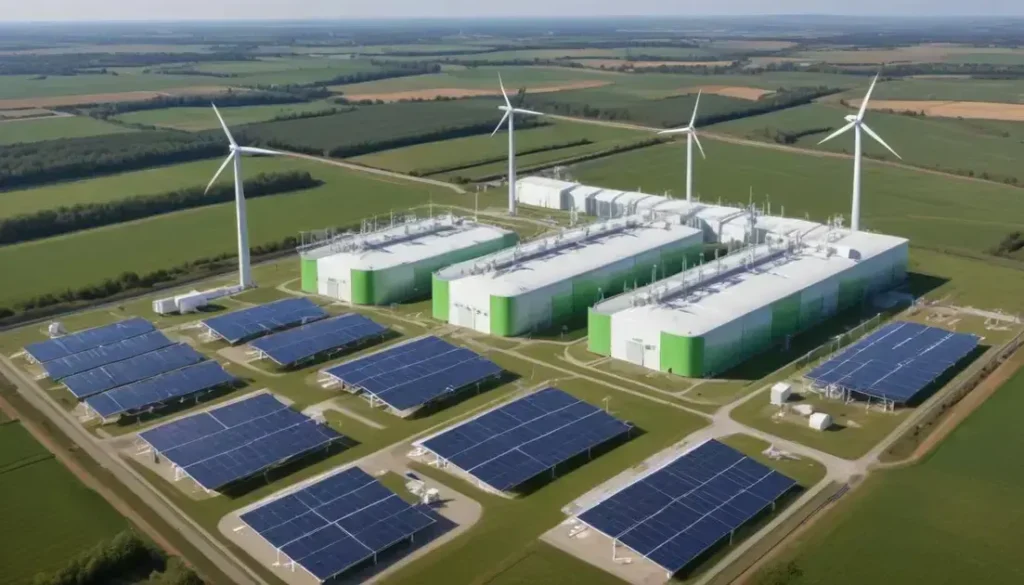Strategic planning for businesses in the context of climate risks involves conducting thorough risk assessments, implementing resilience measures, engaging stakeholders, and integrating sustainability into operations to enhance adaptability and ensure long-term success in a changing environment.
In today’s world, climate risk isn’t just an environmental concern; it’s a pressing issue that affects businesses globally. Understanding its implications is vital for success. Have you considered how it might impact your operations?
Understanding the connection between climate risk and value chains
Climate risk significantly influences value chains, with businesses facing increased challenges from unpredictable weather patterns and natural disasters. These risks can disrupt the flow of goods and services, leading to potential financial losses. Understanding how climate-related events affect various sectors is crucial for businesses aiming to maintain resilience.
Impact on Supply Chains: For instance, industries reliant on agriculture are particularly vulnerable. Crop failures due to droughts or floods can lead to shortages and affect suppliers’ ability to meet demands. In turn, this impacts manufacturers downstream who rely on consistent inputs.
Moreover, climate risk does not only affect agricultural sectors. Manufacturing and logistics are also at stake. Transportation routes may become compromised due to extreme weather, causing delays and additional costs. Companies must assess these vulnerabilities within their supply chains to enhance their risk management strategies.
Investing in technologies that provide real-time data on climate conditions can help businesses foresee potential disruptions. By fostering strong relationships with suppliers and diversifying sources, companies can mitigate risks further. A comprehensive understanding of these connections between climate risk and value chains is essential for adapting to a rapidly changing environment.
Defining physical climate risks: acute vs chronic
Physical climate risks can be categorized into acute and chronic risks, each significantly impacting businesses and economies. Acute risks include extreme weather events such as hurricanes, floods, and droughts. These sudden occurrences can cause immediate and substantial damage, disrupting operations and supply chains.
On the other hand, chronic risks develop gradually over time. They encompass long-term changes in climate, like rising temperatures, sea level rise, and shifting precipitation patterns. These cumulative effects can lead to persistent challenges such as water scarcity and diminishing agricultural yields, affecting resource availability.
Understanding the difference between these risks is vital for companies to develop effective adaptation strategies. For instance, acute risks may require emergency response plans and immediate mitigation measures, while chronic risks call for long-term planning and investments in sustainability.
Businesses that fail to recognize and address these distinct types of risks may face increased costs, reduced market competitiveness, and reputational damage. Employing risk assessment frameworks that account for both acute and chronic climate risks allows organizations to enhance resilience, implement proactive measures, and protect their investments.
Recent economic impacts of climate change on global economies
Climate change has led to significant economic impacts on global economies, affecting various sectors in profound ways. Industries such as agriculture, manufacturing, and tourism have faced severe disruptions due to changing weather patterns and extreme events. These shifts can result in lower productivity, increased operational costs, and supply chain uncertainties.
For example, agricultural yields have been adversely affected by droughts and floods, leading to food shortages and price increases. This not only impacts farmers but also raises costs for consumers and businesses relying on these products. In countries heavily dependent on agriculture, this can plunge local economies into distress.
Additionally, the manufacturing sector is grappling with climate risks that disrupt supply chains. Raw materials may become less accessible due to environmental changes, leading to delays and increased prices. Businesses are therefore compelled to reassess their sourcing strategies to mitigate these risks.
Tourism, another critical sector, faces challenges from extreme weather and rising sea levels. Popular destinations may experience a decline in visitor numbers, affecting local economies dependent on tourism revenue. Addressing these challenges requires comprehensive strategies that incorporate sustainability and resilience to adapt to the evolving economic landscape influenced by climate change.
Sectors most at risk from climate change
Various sectors face significant risks due to climate change, leading to potential disruptions and financial losses. The agricultural sector is among the most vulnerable. Erratic weather patterns, droughts, and flooding can severely impact crop yields, threatening food security and farmers’ livelihoods.
Another sector at risk is transportation. With rising sea levels and extreme weather events, the integrity of transport infrastructure may be compromised. This can lead to increased shipping costs and delays, affecting global supply chains.
The energy sector also encounters challenges as climate change affects energy production and consumption patterns. Increased temperatures can lead to higher demand for cooling, straining energy resources, while renewable energy sources may be impacted by shifting weather systems.
Moreover, the tourism industry is directly influenced by climate conditions. Regions that rely on natural beauty and stable climates may see a decline in visitors due to extreme weather or environmental degradation. Adapting to these uncertainties is imperative for sustaining economic vitality.
Finally, the insurance sector must grapple with rising claims from natural disasters. As the frequency of extreme weather increases, insurers face mounting financial pressure, prompting them to reassess their risk models.
The role of adaptation in climate risk management
Adaptation plays a crucial role in climate risk management, enabling businesses and communities to prepare for, respond to, and recover from the impacts of climate change. Effective adaptation strategies are essential to minimizing vulnerabilities and ensuring long-term sustainability.
One approach is to enhance infrastructure resilience. This involves upgrading buildings, roads, and utilities to withstand extreme weather events. By investing in robust infrastructure, communities can reduce the physical and economic damage caused by climate-related incidents.
Another important aspect of adaptation is the integration of sustainable practices into business operations. Companies can adopt environmentally-friendly technologies and methods that not only reduce carbon footprints but also increase efficiency. For instance, utilizing renewable energy sources can mitigate dependence on fossil fuels while decreasing operational costs.
Furthermore, businesses should engage in vulnerability assessments to identify specific risks within their operations. These assessments enable organizations to develop tailored adaptation strategies that address their unique challenges. Training employees and raising awareness about climate risks can also strengthen a company’s overall resilience.
Finally, collaboration between governments, businesses, and communities is vital for facilitating comprehensive adaptation efforts. Sharing knowledge and resources can pave the way for innovative solutions that enhance collective climate resilience.
How businesses can respond to climate shocks
Businesses face significant challenges when responding to climate shocks, which can disrupt operations and impact the bottom line. Developing a proactive response strategy is essential for minimizing risks and ensuring sustainability. One effective approach is to conduct thorough risk assessments to identify vulnerabilities in processes, supply chains, and infrastructure.
Investing in adaptation measures can enhance resilience against climate impacts. This might include upgrading facilities to withstand extreme weather, diversifying supply sources, or implementing water-saving technologies. By doing so, companies can maintain operations even during adverse conditions.
Another crucial step is to prioritize employee training. Educating staff about potential climate risks and response protocols fosters a culture of preparedness. Employees equipped with knowledge are more likely to react effectively during crises, helping to safeguard the business.
Moreover, building strong stakeholder relationships is vital for effective response. Collaborating with suppliers, local governments, and communities can create a unified approach to dealing with climate shocks. Engaging in dialogues and sharing resources can lead to innovative solutions that benefit all parties.
Lastly, businesses should consider integrating sustainability practices into their core strategies. This not only addresses climate threats but also enhances brand reputation and market competitiveness.
Investment in resilience measures: a necessity
Investment in resilience measures is increasingly recognized as a necessity for businesses facing the impacts of climate change. As extreme weather events become more frequent and severe, organizations must prioritize funding for infrastructure upgrades and sustainable practices to adapt effectively.
One key area of investment is in infrastructure resilience. Strengthening buildings, roads, and utilities to withstand climate-related hazards can prevent significant damage and financial loss. For instance, retrofitting structures to withstand floods or implementing drainage systems can mitigate risks associated with heavy rainfall.
Additionally, investing in renewable energy sources not only reduces carbon footprints but also enhances energy security. By integrating solar panels or wind turbines, businesses can become less reliant on traditional energy sources, making them more resilient to energy supply disruptions.
Furthermore, organizations must consider investing in employee training to cultivate a workforce equipped to handle climate impacts. Training programs focused on sustainability practices and emergency response can significantly improve a company’s adaptive capacity.
Collaborations with local governments and environmental organizations can also amplify the effectiveness of investment strategies. By pooling resources and knowledge, businesses can implement comprehensive resilience initiatives that benefit both the organization and the broader community.
The importance of supplier substitutability
The importance of supplier substitutability cannot be overstated in today’s volatile market landscape. Businesses that rely on a single supplier are particularly vulnerable to disruptions caused by climate change or other unforeseen events. By developing a strategy for supplier diversity, companies can enhance their resilience and ensure that operations continue smoothly.
One primary benefit of having multiple suppliers is the guarantee of consistent product availability. If one supplier faces challenges such as natural disasters, transportation issues, or regulatory changes, alternatives can quickly fill the gap. This ensures that companies can meet customer demand without interruption.
Additionally, relying on various suppliers often leads to increased competition. This competitive environment drives innovation and may result in better pricing, improved services, and higher quality products. Businesses can negotiate more favorable terms when they are not locked into contracts with a single source.
Moreover, diversification of suppliers encourages businesses to assess their supply chain resilience regularly. Companies can identify potential risks and vulnerabilities while actively seeking out new, sustainable partners. This proactive approach is essential in adapting to the challenges posed by climate change and other global disruptions.
Ultimately, fostering supplier substitutability not only fortifies a company’s supply chain but also enhances overall operational flexibility and sustainability.
Case studies: impacts on specific industries
Case studies demonstrate the diverse impacts of climate change on specific industries, highlighting the urgency of addressing climate risks. The agricultural sector serves as a prime example, where changing weather patterns have led to unpredictable crop yields. Farmers are increasingly facing challenges such as droughts and pest invasions, directly affecting food security and profitability.
Moreover, the tourism industry is experiencing notable changes. Popular travel destinations are grappling with the effects of rising sea levels and extreme weather events. For instance, coastal resorts may find themselves at risk of flooding, leading to decreased visitor numbers and significant revenue loss.
The insurance sector is also feeling the repercussions. Insurers are faced with increasing claims related to natural disasters, driving them to adjust their risk models. This has resulted in higher premiums for businesses and homeowners, further straining finances.
Additionally, the energy industry must navigate the challenges posed by climate change. Extreme weather can disrupt energy production, particularly in renewable sectors like solar and wind, where efficiency may wane during storms or droughts. These case studies highlight the interconnectedness of industries and the need for comprehensive strategies to mitigate climate risks.
By analyzing these impacts, businesses can better prepare for future challenges and develop robust adaptation plans that enhance their resilience.
Future projections: climate risk by 2050
Future projections indicate that climate risk will escalate significantly by 2050, affecting ecosystems, economies, and communities worldwide. Scientists warn that rising global temperatures may lead to more frequent and severe weather events, including hurricanes, droughts, and floods. These changes pose a direct threat to agricultural productivity, compromising food security and livelihoods.
Moreover, sea level rise threatens coastal cities and infrastructure. Urban areas may face increased flooding, resulting in costly repairs and heightened insurance premiums. Businesses in these regions must prepare for potential disruptions and consider relocating if conditions worsen.
Another critical aspect of climate risk is its impact on public health. Increased heatwaves can exacerbate health issues, particularly in vulnerable populations. Vector-borne diseases may also spread as warmer temperatures expand the ranges of mosquitoes and other pathogens.
By 2050, it is expected that companies across various sectors will need to adapt to these changing conditions. This adaptation could involve investing in sustainable practices or technologies that reduce greenhouse gas emissions and increase resilience.
Decision-makers must act promptly to mitigate these risks. Planning for the future requires integrating climate risk assessments into business strategies, ensuring that organizations remain viable in an increasingly uncertain environment.
Conclusion: strategic planning for businesses
Strategic planning for businesses is essential in the face of escalating climate risks. Companies must develop robust frameworks that integrate risk assessment and adaptation measures into their core operations. A proactive approach to climate change can help businesses not only survive but thrive in a challenging environment.
One key component of effective strategic planning is the identification of vulnerabilities within the organization. Conducting regular risk assessments allows businesses to pinpoint areas most susceptible to climate impacts, enabling them to allocate resources efficiently and prioritize necessary adaptations.
Furthermore, engaging stakeholders, including suppliers, customers, and local communities, fosters a collaborative environment. By sharing insights and strategies, businesses can build resilience collectively and adapt more swiftly to changing conditions.
Integrating sustainability into the business model is also paramount. Adopting eco-friendly practices not only mitigates environmental impact but can also lead to cost savings and enhanced brand reputation. Consumers increasingly prefer brands that demonstrate a commitment to sustainability.
Finally, businesses should remain agile in their strategic planning, allowing them to pivot in response to new information or shifting conditions. By being forward-thinking and adaptable, organizations can position themselves as leaders amidst the challenges of climate change.
In Conclusion: Preparing for the Future
Climate change poses significant challenges for businesses, making strategic planning crucial. Companies that proactively assess risks and implement adaptation measures are more likely to succeed in a changing environment.
By involving stakeholders and focusing on sustainability, businesses can enhance their resilience and secure their future. Embracing eco-friendly practices not only protects the environment but also boosts brand loyalty among consumers.
Moreover, agility in planning allows organizations to respond effectively to new challenges. As conditions evolve, the ability to adapt becomes a key strength.
Ultimately, strategic planning is not just about survival; it is a pathway to growth and innovation in the face of climate risks. By taking action now, businesses can position themselves for a brighter and more sustainable future.
Frequently Asked Questions
How can businesses prepare for climate risks?
Businesses can prepare by conducting risk assessments, implementing adaptation strategies, and involving stakeholders in the planning process.
What are resilience measures?
Resilience measures are actions taken to strengthen a business’s ability to withstand climate impacts, such as upgrading infrastructure or diversifying suppliers.
Why is supplier substitutability important?
Supplier substitutability is important because it reduces dependency on a single supplier, ensuring consistent product availability and enhancing operational stability.
What role does sustainability play in strategic planning?
Sustainability is crucial in strategic planning as it helps businesses reduce their environmental impact and improve their reputation in the market.
How can businesses collaborate with local communities?
Businesses can collaborate by engaging with community leaders, sharing resources, and participating in local sustainability initiatives to support resilience.
What long-term benefits come from strategic planning for climate risks?
Long-term benefits include improved operational efficiency, increased customer loyalty, and better overall resilience to future climate challenges.


